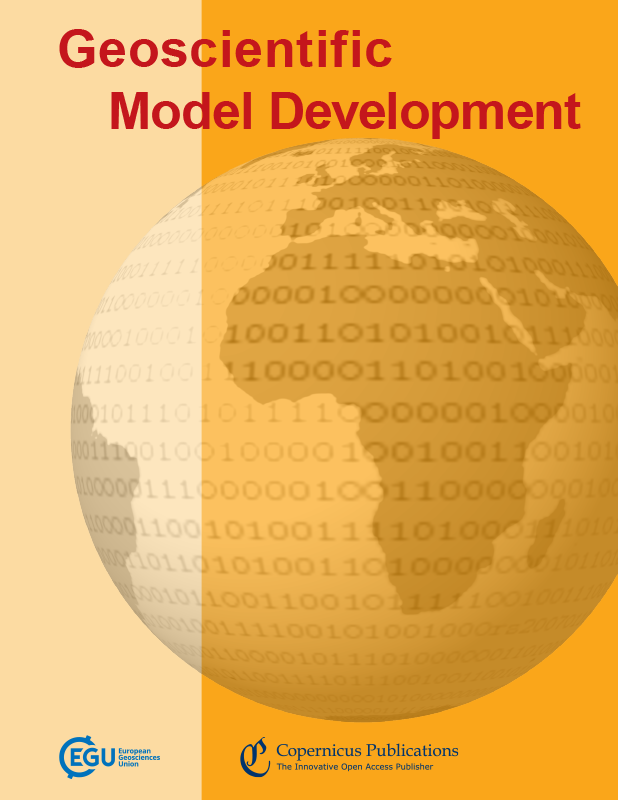欧拉方法与拉格朗日方法在水柱中垂直粒子输运的比较
IF 4.9
3区 地球科学
Q1 GEOSCIENCES, MULTIDISCIPLINARY
引用次数: 0
摘要
摘要海洋学的一个常见任务是模拟微粒的垂直运动,如微塑料、纳米粒子、矿物粒子、气泡、油滴、鱼卵、浮游生物或藻类。在某些情况下,所讨论的颗粒的垂直上升或沉降速度的分布可以跨越很宽的范围,覆盖几个数量级,这通常是由于广泛的颗粒尺寸分布或密度的差异。这就要求数值方法能够充分解析宽的、可能的多模态速度分布。拉格朗日粒子法通常用于这些应用。这种方法的一个优点是,每个粒子都有自己的上升或沉降速度,这使得它很容易获得速度连续分布的良好表示。另一种方法是使用欧拉方法,其中用数值方法直接求解描述输运问题的偏微分方程。在欧拉方法中,不同的上升或沉降速度必须表示为离散的类,而在实践中,只能包括有限数量的类。在这里,我们考虑了水柱模型的三种不同应用实例:正浮力的鱼卵,正浮力和负浮力微塑料的混合物,以及被波浪夹带的正浮力油滴。对于每一种情况,我们都建立了一个基于平流扩散方程的垂直输运模型,并在适当的边界条件下,在一种情况下,有一个反应项。我们给出了这些模型的欧拉和拉格朗日实现的详细描述,并证明了它们对选定的例子给出了等效的结果。我们还特别注意了模型结果随欧拉格式中类数的增加和拉格朗日格式中粒子数的增加的收敛性。对于拉格朗日方案,我们看到1/Np收敛,正如蒙特卡罗方法所期望的那样,而对于欧拉实现,我们看到二阶(1/Nk2)收敛与类的数量。本文章由计算机程序翻译,如有差异,请以英文原文为准。
A comparison of Eulerian and Lagrangian methods for vertical particle transport in the water column
Abstract. A common task in oceanography is to model the vertical movement of particles such as microplastics, nanoparticles, mineral particles, gas bubbles, oil droplets, fish eggs, plankton, or algae. In some cases, the distribution of the vertical rise or settling velocities of the particles in question can span a wide range, covering several orders of magnitude, often due to a broad particle size distribution or differences in density. This requires numerical methods that are able to adequately resolve a wide and possibly multi-modal velocity distribution. Lagrangian particle methods are commonly used for these applications. A strength of such methods is that each particle can have its own rise or settling speed, which makes it easy to achieve a good representation of a continuous distribution of speeds. An alternative approach is to use Eulerian methods, where the partial differential equations describing the transport problem are solved directly with numerical methods. In Eulerian methods, different rise or settling speeds must be represented as discrete classes, and in practice, only a limited number of classes can be included. Here, we consider three different examples of applications for a water column model: positively buoyant fish eggs, a mixture of positively and negatively buoyant microplastics, and positively buoyant oil droplets being entrained by waves. For each of the three cases, we formulate a model for the vertical transport based on the advection–diffusion equation with suitable boundary conditions and, in one case, a reaction term. We give a detailed description of an Eulerian and a Lagrangian implementation of these models, and we demonstrate that they give equivalent results for selected example cases. We also pay special attention to the convergence of the model results with an increasing number of classes in the Eulerian scheme and with the number of particles in the Lagrangian scheme. For the Lagrangian scheme, we see the 1/Np convergence, as expected for a Monte Carlo method, while for the Eulerian implementation, we see a second-order (1/Nk2) convergence with the number of classes.
求助全文
通过发布文献求助,成功后即可免费获取论文全文。
去求助
来源期刊

Geoscientific Model Development
GEOSCIENCES, MULTIDISCIPLINARY-
CiteScore
8.60
自引率
9.80%
发文量
352
审稿时长
6-12 weeks
期刊介绍:
Geoscientific Model Development (GMD) is an international scientific journal dedicated to the publication and public discussion of the description, development, and evaluation of numerical models of the Earth system and its components. The following manuscript types can be considered for peer-reviewed publication:
* geoscientific model descriptions, from statistical models to box models to GCMs;
* development and technical papers, describing developments such as new parameterizations or technical aspects of running models such as the reproducibility of results;
* new methods for assessment of models, including work on developing new metrics for assessing model performance and novel ways of comparing model results with observational data;
* papers describing new standard experiments for assessing model performance or novel ways of comparing model results with observational data;
* model experiment descriptions, including experimental details and project protocols;
* full evaluations of previously published models.
 求助内容:
求助内容: 应助结果提醒方式:
应助结果提醒方式:


